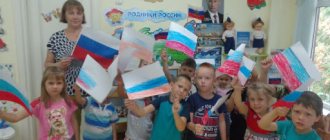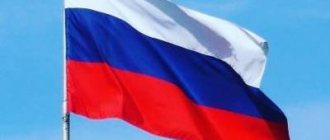Open lesson on patriotic education in the preparatory group “Travel across Russia”
No country in the world has such a vast territory as Russia. (The teacher circles the territory of our country with a pointer).
When people go to bed at one end of our country, morning begins at the other. To get from one end of our country to the other by train, you need to travel 7 days, and fly by plane for 24 hours.
Guys, who will answer me one difficult question: “What continent is Russia located on?” ( The country of Russia is located on the continent of Eurasia , which includes two parts of the world : Europe and Asia).
Physical exercise “Our Motherland – Russia”
In our country the mountains are high,
(
stretch on our tiptoes
)
The rivers are deep,
(
squat down
)
The steppes are wide,
(
we spread our arms
)
The forests are large,
(
arms up
)
And we are the guys like that!
(
show thumb
)
Educator: Oh, guys, I think I see a Chamomile petal ! (The teacher picks up a hidden petal from the floor).
Hooray! We found it and will give it to our Romashka! (The child attaches a petal to the board.) Well, let's move on! Go!
Stop No. 2: “Symbols of Russia”
Each country has its own state symbols: coat of arms, flag and anthem. Guys, look at the coat of arms.
Coat of arms
is the emblem of the state. “The state emblem of the Russian Federation is an image of a golden double-headed eagle placed on a red heraldic shield; above the eagle are three historical crowns of Peter the Great (above the heads are two small ones and above them is one larger); in the eagle’s paws are a scepter and an orb; on the eagle’s chest on a red shield is a horseman slaying a dragon with a spear.”
Ksyusha D.:
Russia has a majestic double-headed eagle on its coat of arms, so that He could look to the west and east at once. He is strong, wise and proud. He is Russia's free spirit.
Flag of the Russian Federation
has three colors: white, blue and red.
White color means peace, purity; blue color is a symbol of faith and fidelity; red color symbolizes energy, strength, blood shed for the Fatherland.
Grisha:
Multi-colored flag of Russia - White, blue, red. The most beautiful for me, There is no more beautiful flag in the world. There is honor and truth in this flag, Blood shed in battle, Courage, valor and bravery, Faith in my Motherland!
Hymn.
The national anthem of the Russian Federation is performed during ceremonies and other events held by government bodies.
When the anthem is performed in public, those present listen to it standing, men without hats. Our anthem was written by composer Alexander Alexandrov and poet Sergei Mikhalkov. Let's listen to the Russian anthem. (Children stand up. The teacher plays the anthem of the Russian Federation).
Anya:
The Russian Anthem sounded majestically and calmly. Everyone listened, quietly, standing, and the audience held its breath.
“theatrical activities in instilling love for the homeland in older preschoolers”
"Theatrical activities in education
love for the Motherland among older preschoolers"
Bagdasaryan Haykanush Armavirovna
MBDOU DS No. 40 "Berezka"
g.o. Serpukhov, Moscow region
In the modern system of preschool education, the question is increasingly being raised that in developing a child’s personality, in nurturing his moral qualities, it is necessary to use all available pedagogical resources. Preschool pedagogy of the present time has various areas of educational influence on the child. One of these areas is the theatrical activities of preschoolers. What is the importance of theatrical activities in the development of a child?
Theater in kindergarten teaches a preschooler to see beauty in people and the things around them, therefore, an aesthetic attitude to reality is formed. It is important to remember that theatrical art is synthetic in nature: there is music and dance, speech and visual activity. One cannot fail to mention the formation and development of such mental processes as memory, attention, thinking... This type of activity is fertile ground for the formation of social behavioral skills, since every fairy tale and every other literary work, which, as is known, are the basis for dramatization games and Similar theatrical productions for preschoolers, created for children, always have a moral orientation; they contain themes of kindness, courage, friendship, and love for the Fatherland.
Theatrical activities make it possible to understand the world around us not only with the mind, but also with the heart, to express one’s own attitude towards the categories of “good” and “evil”, “loyalty” and “betrayal”; this activity forms in children the idea of love: for relatives, for friends, to people in general, ideas about good and evil, justice, etc. Let’s ask ourselves a question: how are the theatrical activities of a preschooler in kindergarten and love for the Motherland connected? To answer this question, let us turn to the essence of patriotic education.
What is love for the Motherland, the Fatherland, in the understanding of a small child? The difficulty of instilling patriotic feelings in preschool children stems from their very age. We, adults, cannot finally form a single moral quality at a given age, and the education of patriotic feelings undoubtedly refers to moral education. The task of teachers and parents is to sow the seed of love for the Motherland. First of all, you need to pay attention to the connection between words. The father is the Fatherland, and the mother also lives in the Fatherland, and the whole family lives; parents - Motherland.
It is known that love for one’s country cannot arise immediately as a given. This feeling goes through several stages of appearance - love for parents, for one’s home, relatives and friends, for the nature of one’s region, for compatriots, for the history, traditions and culture of the region. If a little person, with the help of an adult, has walked this path, then we can say: the seeds of citizenship and patriotism have grown in his soul, and the child’s love for his homeland has arisen.
What does it mean to love the Fatherland? Love is a feeling that is expressed not only in attitude, but also in actions; it is versatile. Raising patriotic feelings in a child is the formation of responsibility for one’s behavior and actions; awakening the desire and ability to work for the benefit of one’s country and one’s compatriots; training in the desire to preserve and increase the wealth of the Motherland; formation of aesthetic views.
Teachers in kindergarten achieve all this in different ways: they teach children to take care of toys, books, plants in the group and on the street, they teach them to work together and individually for the benefit of themselves and their peers, the group, and introduce them to a vision of the beauty of the world around them.
Scientists and educators involved in the study of children's theatrical games note that the life of a preschool child is closely connected with play. Everything a child does in relation to the theater is aimed at solving a game problem. S.A. Kozlov and T.A. Kulikova O.
The problem of our research was to identify the existence of a relationship between the introduction of children of senior preschool age to theatrical activities and the cultivation of love for the Motherland. The Russian folk tale “Teremok” was chosen as a dramatized work with children of senior preschool age. We have set ourselves the following tasks: nurturing love for the Motherland, maintaining interest in theatrical activities, and developing teamwork skills. The dramatization game was intended as a production of a fairy tale for children of primary preschool age. The children and I were preparing a tabletop theater performance.
Stages of work:
1. Selecting a work. The children chose the fairy tale with the indirect guidance of the teacher. Since the main goal was to cultivate love for the Motherland, the children were asked to choose a Russian folk tale about a house common to different residents. The children suggested such options as “Zayushkina’s hut”, “Winter hut of animals”, but most of the children expressed a desire to prepare the fairy tale “Teremok”.
2. Reading a fairy tale. The teacher's initial expressive reading of a fairy tale, familiar to most children, did not involve discussion of the text; upon repeated reading, we began to analyze the text. Particular attention was paid to the interpretation of the characters’ actions, their characters, and awareness of the motivation for their actions. The children noted such character traits as hospitality, lack of fear of cramped conditions, kindness, which is expressed by the heroes in one phrase: “come live with us...”.
Polina B. commented on this moment: “Dad says, we always let everyone in like this...”, accordingly, it can be assumed that the girl connected the actions of the characters with the Russian mentality.
3. Dividing the work into semantic parts - the children associated each semantic part of the text with the appearance of a new character.
4. Playing individual episodes. The task of this stage of work was to identify difficulties in the execution of individual moments. The children found it most difficult to convey the intonation characteristics of the characters. The teacher helped the children in choosing expressive means to more accurately convey the characteristics of the characters’ characters. Particular attention was paid to discussing the actions of the characters in line with patriotic education.
For example, when the bear replayed the moment of breaking the tower, the animals, although upset, got back to work and built a new tower “better than the previous one.” The teacher drew the children's attention to the relationship between the life problems of the fairy tale characters and the fact that it is typical for a Russian person to always find a way out of a difficult situation through mutual support and mutual assistance. We, taking into account the older preschool age, gave an example of the restoration of the country after the Great Patriotic War.
5. Distribution of roles - passed without conflicts, since the children knew that the fairy tale would be played out more than once, and everyone would be able to express themselves in the roles of different characters.
6. Making the attributes of a dramatization game. At a joint discussion, it was decided to make a “Teremok” house using colored cardboard and colored paper, and mold character dolls from plasticine. The teacher paid special attention to the fact that Teremok, a small tower, is an original Russian structure, characteristic only of our people. The animal characters of the fairy tale are also animals of central Russia. The people who created the fairy tale saw in each animal a separate character, a prototype of an individual person, but in general, the “group” of animals represents the original Russian mentality, the general character of the entire nation.
7. Game-dramatization based on a fairy tale. The fairy tale was shown to children of two younger age groups.
Thus, we have proven the existence of a close relationship between introducing children to theatrical activities and nurturing love for the Motherland.


